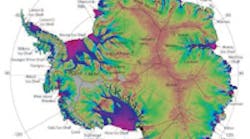Recently, climate-change research achieved a major milestone. For the first time, a NASA-funded research team has comprehensively mapped the speed and direction of ice flow in Antarctica. The resulting map shows glaciers flowing thousands of miles from the continent's deep interior to its coast (see figure). As a result, the map is sure to become a critical tool in tracking future sea-level increases.
The work was conducted by Eric Rignot, Jeremie Mouginot, and Bernd Scheuchl from the University of California, Irvine, in conjunction with the International Polar Year (IPY; 2007-2008). The collaborators worked under the IPY Space Task Group, which included NASA; the European Space Agency (ESA); the Canadian Space Agency (CSA); the Japan Aerospace Exploration Agency; the Alaska Satellite Facility in Fairbanks; and MacDonald, Dettwiler, and Associates of Richmond, British Columbia, Canada.
The map was created using integrated radar observations from a consortium of European, Japanese, and Canadian satellites. Aided by NASA technology, the team pieced together the shape and velocity of glacial formations. Among these were the previously uncharted formations of East Antarctica, which comprises 77% of the continent. The map also built upon partial charts of Antarctic ice flow that had been created by NASA, the CSA, and the ESA using different techniques.
Upon completion of the project, the team discovered a new ridge splitting the 5.4-million-square-mile landmass from east to west. In addition, unnamed formations were observed sloping toward the Antarctic Ocean. Traveling up to 800 feet annually across immense plains, they were shown to be moving differently than past models of ice migration. "The map points out something fundamentally new: that ice moves by slipping along the ground it rests on," says Thomas Wagner, a scientist with NASA's Cryospheric Program. "That's critical knowledge for predicting future sea level rise. It means that if we lose ice at the coasts from the warming ocean, we open the tap to massive amounts of ice in the interior."
For a video animation of the new Antarctic map, visit: http://1.usa.gov/poJq1P.

